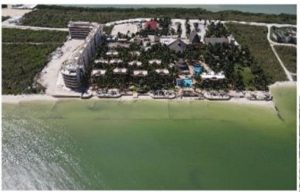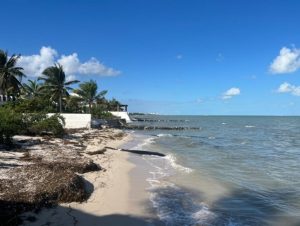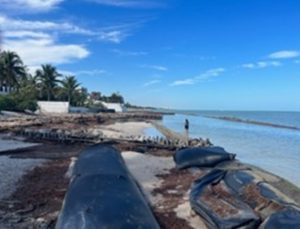Retreat, Defend or Attack?
As water energy increases due to the rising sea temperatures, coasts are eroded, and where once were beautiful stretches of sand, there is now sea, waves, sometimes debris.
The coast is important not only for its beauty and potential for well-being and recreation. Its beach and dune system serves as a “buffer” that absorbs the wave energy and protects cities, hotels, buildings, properties and structures that are close to the sea from being flooded and eroded, gradually losing functionality and economic value. The photo below shows a coastal hotel in Mexico, where the beach is no more.

There are 3 approaches: Retreat, Defend or Attack.
What is “Retreat”? Let’s say your house is on the coast and the waves are gradually getting closer, especially during storms, risking the infrastructure, requiring you to invest repeatedly in reinforcement or you lose the entire value of your property. Why not move the property back some 50 meters? This approach is sometimes applied by authorities, typically where houses can be moved and/or the authorities do not want rigid structures, but how far can you retreat? Is it even practical? More importantly, this approach addresses the symptoms, yet the problem remains.
Alternatively, one can “Defend” one’s property or coastline by constructing sea walls, revetments or dune cores. With this approach, one draws a hard line in the sand with the intent to not let the erosion continue any further. This can prevent further erosion behind the structure thus achieving its goal of protecting the property. On the other hand, it often results in aggressive erosion in front of the structure, especially during storms. The beach must be periodically maintained, which may not always be practical or feasible.
Finally, “Attack”. Constructing permanent rigid structures made of stone, geotextile tubes and concrete. For such structures, it is critical that data related to waves, currents, winds, climate conditions, 100-year estimates, range of influence and more factors, is carefully and thoroughly considered during the design & engineering phase. These structures are expensive, and they must be installed by contractors experienced in marine environments because conditions at sea are extremely different than on land.
When the design is lacking and/or installation is not professional, erosion may be expedited. In the left photo below, we see an eroded coastline. In October 2024 residents took matters into their own hands and arranged for construction of a few stone “fingers” into the sea. The sea was “unimpressed” and less than 3 months later, in February 2025, the situation became much worse as shown in the right photo.


One of the disadvantages of the “attack” methodology is that even when properly designed and executed, while these structures may solve the problem in one coast segment, they “shift” it further down, to adjacent coasts that are not protected. Additionally, every permanent construction on the shore or at sea must be done carefully and respectfully, because it invades living habitats and effects coastal and shallow water marine life, sea birds and entire food chains that are critical for the sustainability and health of our planet.
Terra Sea and its colleagues’ experience proves that nature becomes part of the solution when one works with nature and does not try to force it. The design engineering team must carefully evaluate the minimally sufficient level of intervention and select high quality materials for an effective, sustainable, long-term solution that works with nature.
In our coming posts, we will address application of the “defend” and rigid “attack” structures in detail as well as various types of “soft” solutions and advanced technologies, solutions and methods, that in many cases can solve coastal erosion effectively and economically.
This is the second post in our series on Coastal Erosion. Our posts are also posted on LinkedIn. We invite you to follow us on LinkedIn.
Nelly
February 27th, 2025
